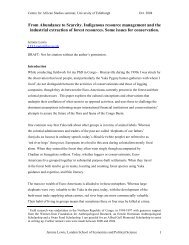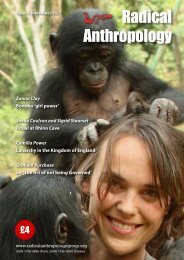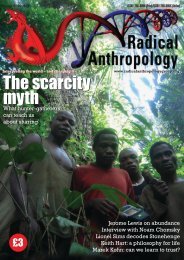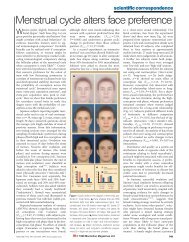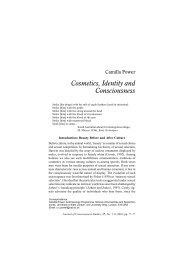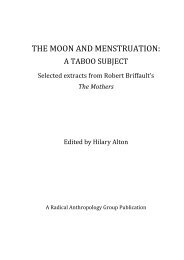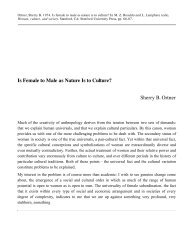Language and life history: A new perspective on the development ...
Language and life history: A new perspective on the development ...
Language and life history: A new perspective on the development ...
- No tags were found...
Create successful ePaper yourself
Turn your PDF publications into a flip-book with our unique Google optimized e-Paper software.
Locke & Bogin: <str<strong>on</strong>g>Language</str<strong>on</strong>g> <str<strong>on</strong>g>and</str<strong>on</strong>g> <str<strong>on</strong>g>life</str<strong>on</strong>g> <str<strong>on</strong>g>history</str<strong>on</strong>g>tools, <str<strong>on</strong>g>and</str<strong>on</strong>g> a greater diversity of st<strong>on</strong>e tool types associatedwith H. habilis than with any earlier hominins (Klein1989). There is c<strong>on</strong>siderable evidence that some of <strong>the</strong>setools were used to scavenge animal carcasses, especiallyto break open l<strong>on</strong>g b<strong>on</strong>es <str<strong>on</strong>g>and</str<strong>on</strong>g> extract b<strong>on</strong>e marrow(Plummer 2004; Potts 1988). This behavior may be interpretedas a strategy to feed children. Such scavenging mayhave been needed to provide <strong>the</strong> essential amino acids,some of <strong>the</strong> minerals, <str<strong>on</strong>g>and</str<strong>on</strong>g>, especially, <strong>the</strong> fat (densesource of energy) that children require for growth of <strong>the</strong>brain <str<strong>on</strong>g>and</str<strong>on</strong>g> body (Le<strong>on</strong>ard & Roberts<strong>on</strong> 1992; Le<strong>on</strong>ardet al. 2003).A fur<strong>the</strong>r increase in brain size occurred during <strong>the</strong> timeof H. erectus, which began about 1.9 milli<strong>on</strong> years ago. Theearliest adult specimens have mean brain sizes of 826 cc,but many individual adults had brain sizes between 840<str<strong>on</strong>g>and</str<strong>on</strong>g> 1059 cc (Coqueugnoit et al. 2004). Inserti<strong>on</strong> or expansi<strong>on</strong>of childhood would have provided <strong>the</strong> time needed fora rapid, human-like, pattern of postnatal brain growth. 16It should be noted in Figure 3 that <strong>the</strong> model of humanevoluti<strong>on</strong> proposed here predicts that from Australopi<strong>the</strong>custo H. erectus infancy shrinks as childhood exp<str<strong>on</strong>g>and</str<strong>on</strong>g>s. In<strong>the</strong> time of early H. erectus <strong>the</strong> transiti<strong>on</strong> from infancy tochildhood took place before M1 erupti<strong>on</strong>. If <strong>the</strong> <str<strong>on</strong>g>new</str<strong>on</strong>g> childhoodwas stolen from infancy, or reduced its length, <strong>the</strong>nH. erectus would have enjoyed a greater reproductiveadvantage than any previous hominin. This seems tohave been <strong>the</strong> case, since H. erectus populati<strong>on</strong>s increasedin size <str<strong>on</strong>g>and</str<strong>on</strong>g> began to spread throughout Africa <str<strong>on</strong>g>and</str<strong>on</strong>g> o<strong>the</strong>rregi<strong>on</strong>s of <strong>the</strong> Old World (Antón 2003).Figure 3 also shows later H. erectus, with an averageadult brain size of 983 cc <str<strong>on</strong>g>and</str<strong>on</strong>g> a fur<strong>the</strong>r expansi<strong>on</strong> of <strong>the</strong>childhood stage. In additi<strong>on</strong> to larger brains (somemeasuring 1100 cc), <strong>the</strong> archaeological record for laterH. erectus shows increased complexity of technology(tools, fire, <str<strong>on</strong>g>and</str<strong>on</strong>g> shelter) <str<strong>on</strong>g>and</str<strong>on</strong>g> social organizati<strong>on</strong> (Antón2003; Klein 1989). These techno-social advances, <str<strong>on</strong>g>and</str<strong>on</strong>g> aparallel increase in learning, may well reflect extendedchildhood (Bogin & Smith 1996). The evoluti<strong>on</strong>ary transiti<strong>on</strong>to archaic, <str<strong>on</strong>g>and</str<strong>on</strong>g> finally, modern H. sapiens exp<str<strong>on</strong>g>and</str<strong>on</strong>g>s<strong>the</strong> childhood stage to its current length.As for how childhood abetted language, we speculatethat <strong>the</strong>re was a process of coevoluti<strong>on</strong>, according towhich an initially short childhood period facilitated <strong>the</strong>emergence of a small amount of vocal-verbal behavior.Even if <strong>the</strong> original cause of childhood was n<strong>on</strong>linguistic,as we propose, any <str<strong>on</strong>g>new</str<strong>on</strong>g> time between infancy <str<strong>on</strong>g>and</str<strong>on</strong>g> juvenilitywould have provided <strong>the</strong> young with additi<strong>on</strong>al opportunitiesfor vocal-verbal interacti<strong>on</strong> during a time ofincreased independence, <str<strong>on</strong>g>and</str<strong>on</strong>g> would have given adults<str<strong>on</strong>g>new</str<strong>on</strong>g> reas<strong>on</strong>s to h<strong>on</strong>estly inform any dependents in <strong>the</strong>ircare (Fitch 2004). The dispositi<strong>on</strong> to do so is suggestedby <strong>the</strong> fact that primate mo<strong>the</strong>rs appear to prevent <strong>the</strong>iryoung from eating alien substances, <str<strong>on</strong>g>and</str<strong>on</strong>g> warn off younganimals that approach toxic fruits (Caro & Hauser 1992).Young hominins also would have needed to know aboutplants as well as game, tools, shelter, <str<strong>on</strong>g>and</str<strong>on</strong>g> predators.Even a small amount of vocal-verbal behavior wouldhave facilitated warnings <str<strong>on</strong>g>and</str<strong>on</strong>g> instructi<strong>on</strong>. Childhoodleng<strong>the</strong>ned, enabling more language which, in turn,extended childhood, until <strong>the</strong> <str<strong>on</strong>g>new</str<strong>on</strong>g> <strong>on</strong>togenetic stagereached its present length. Childhood would thus haveoffered up <str<strong>on</strong>g>new</str<strong>on</strong>g> behaviors, <strong>on</strong>es that would also provebeneficial in <strong>the</strong> run up to sexual maturity.9.2. Evoluti<strong>on</strong> of adolescenceThis brings us to <strong>the</strong> evoluti<strong>on</strong> of <strong>the</strong> o<strong>the</strong>r uniquelyhuman stage of <strong>development</strong>. N<strong>on</strong>human primates lackchildhood, but <strong>the</strong>y also lack a post-juvenile period of dramaticgrowth of <strong>the</strong> sort that defines human adolescence.Unfortunately, very little is known about <strong>the</strong> evoluti<strong>on</strong> ofadolescence. It is possible, however, to suggest somebenefits of this late stage of <strong>development</strong> in terms of reproductivebiology, social ecology, <str<strong>on</strong>g>and</str<strong>on</strong>g> reproductive success.Our claim, detailed elsewhere (Bogin 1999a; 1999b;2003), is that adolescence became part of human <str<strong>on</strong>g>life</str<strong>on</strong>g><str<strong>on</strong>g>history</str<strong>on</strong>g> because it c<strong>on</strong>ferred significant reproductiveadvantages <strong>on</strong> our evoluti<strong>on</strong>ary ancestors, in part by allowingadolescents to learn <str<strong>on</strong>g>and</str<strong>on</strong>g> practice adult ec<strong>on</strong>omic,social, <str<strong>on</strong>g>and</str<strong>on</strong>g> sexual behaviors before reproducing. As indicatedin secti<strong>on</strong> 2.7, <strong>the</strong> basic argument for <strong>the</strong> evoluti<strong>on</strong><str<strong>on</strong>g>and</str<strong>on</strong>g> benefits of human adolescence is that girls bestlearn <strong>the</strong>ir adult social roles while <strong>the</strong>y are infertile butperceived by adults to be mature, whereas boys bestlearn <strong>the</strong>ir adult social roles while <strong>the</strong>y are sexuallymature but not yet perceived to be such by adults. Theproposed patterns corresp<strong>on</strong>d exactly to <strong>the</strong> course ofgrowth <str<strong>on</strong>g>and</str<strong>on</strong>g> <strong>development</strong> taken by boys <str<strong>on</strong>g>and</str<strong>on</strong>g> girls. Onaverage, healthy girls begin to develop adult-like fatpatterns (e.g., breast, hips) at about age 10 to 11 years,which is two years before <strong>the</strong> peak of <strong>the</strong> adolescentspurt. Menarche occurs a year after <strong>the</strong> spurt <str<strong>on</strong>g>and</str<strong>on</strong>g> isfollowed by about three years of adolescent sterility,ovulati<strong>on</strong> being rare or absent. The female pelvis alsogrows slowly during adolescence <str<strong>on</strong>g>and</str<strong>on</strong>g> does not reach fulladult size, a necessity for successful birth, until aboutage 18 years. Externally, however, <strong>the</strong>se infertile girlslook like women <str<strong>on</strong>g>and</str<strong>on</strong>g> this percepti<strong>on</strong> prompts adults toinclude <strong>the</strong> girls in a suite of adult social, ec<strong>on</strong>omic,sexual, <str<strong>on</strong>g>and</str<strong>on</strong>g> political activities. The girls learn from involvementin <strong>the</strong>se activities <str<strong>on</strong>g>and</str<strong>on</strong>g> arrive at young adulthood, atabout age 19 years, with c<strong>on</strong>siderable experience thattranslates into reproductive success. This may be whyhumans have <strong>the</strong> highest rate of birth survival of anyspecies: 50 to 60% in traditi<strong>on</strong>al foraging societies comparedwith 35% in chimpanzees (Lancaster & Lancaster1983). 17In <strong>the</strong> reverse pattern that characterizes male adolescence,fertile sperm are produced at about 13.5 years ofage, <str<strong>on</strong>g>and</str<strong>on</strong>g> yet external features of male adults (body size,muscularity, body hair, <str<strong>on</strong>g>and</str<strong>on</strong>g> o<strong>the</strong>r sexual features) do notdevelop until about age 18 years. The horm<strong>on</strong>es thatcause spermatogenesis may prime boys to be emoti<strong>on</strong>ally<str<strong>on</strong>g>and</str<strong>on</strong>g> cognitively attentive to <strong>the</strong> behavior of adult men<str<strong>on</strong>g>and</str<strong>on</strong>g> women. In most human societies, boys pass throughseveral rites of passage that help <strong>the</strong>m learn <str<strong>on</strong>g>and</str<strong>on</strong>g> practiceimportant adult male ec<strong>on</strong>omic, social, political, <str<strong>on</strong>g>and</str<strong>on</strong>g>reproductive activities. By age 20 or so, <strong>the</strong>se boys graduateto manhood, <str<strong>on</strong>g>and</str<strong>on</strong>g> are expected to compete successfullywith o<strong>the</strong>r men <str<strong>on</strong>g>and</str<strong>on</strong>g> to assume <strong>the</strong> resp<strong>on</strong>sibilitiesassociated with marriage <str<strong>on</strong>g>and</str<strong>on</strong>g> paternity.As for when adolescence evolved, it is possible that thisstage first appeared in H. erectus, a hominin that originallyevolved in Africa more than <strong>on</strong>e milli<strong>on</strong> years ago (Antón&Leigh 2003). The evidence for this is patterns of tooth formati<strong>on</strong>that are not directly linked to <strong>the</strong> presence of anadolescent growth spurt, but are n<strong>on</strong>e<strong>the</strong>less suggestive.O<strong>the</strong>r research indicates that H. erectus, later hominins274 BEHAVIORAL AND BRAIN SCIENCES (2006) 29:3



